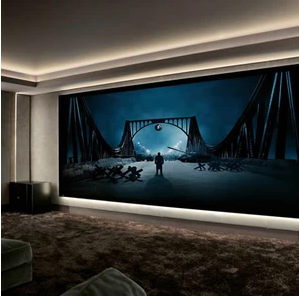Elevate Your Home Entertainment: Choosing the Perfect Home Cinema Screen
In today’s fast-paced world, the allure of a home cinema experience has never been stronger. Whether you’re a movie enthusiast, a gaming aficionado, or simply seeking a cozy space to unwind with loved ones, a well-designed home cinema can transform your entertainment experience. And at the heart of every exceptional home theater lies the cornerstone of visual immersion: the cinema screen.
With a myriad of options available on the market, selecting the ideal home cinema screen can be a daunting task. From size and aspect ratio to material and technology, each factor plays a crucial role in shaping your viewing pleasure. So, let’s embark on a journey to explore the key considerations when choosing the perfect home cinema screen.
1. Size Matters: The size of your screen sets the stage for your cinematic adventure. Consider the dimensions of your room, viewing distance, and seating arrangement to determine the optimal screen size. While larger screens deliver a more immersive experience, ensure it complements your space without overwhelming it.

2. Aspect Ratio: Selecting the right aspect ratio enhances the authenticity of your viewing experience. Whether you prefer the traditional 16:9 widescreen format for modern content or the classic 2.35:1 Cinemascope for a cinematic feel, ensure compatibility with your projector or display device.
3. Screen Material: The material of your cinema screen significantly impacts picture quality and viewing angles. Opt for high-quality materials like matte white or woven acoustically transparent fabric to ensure uniform brightness, minimal hot spotting, and superior color reproduction.
4. Gain and Viewing Angles: Consider the screen gain and viewing angles to optimize brightness and contrast levels across your seating area. A moderate gain of 1.0 to 1.3 is suitable for most environments, while wider viewing angles ensure an immersive experience from every seat in the house.
5. Fixed Frame vs. Motorized: Choose between a fixed frame or motorized screen based on your preferences and space constraints. Fixed frame screens offer a sleek, permanent solution with minimal setup, while motorized screens provide versatility and convenience at the touch of a button.
6. Ambient Light Rejection (ALR) Technology: Combat ambient light interference with ALR technology, which enhances contrast and color saturation in brightly lit environments. ALR screens utilize specialized materials and coatings to preserve image integrity and clarity, making them ideal for multipurpose rooms or living spaces with ample natural light.
7. Budget and Quality: While it’s tempting to splurge on the latest technology, strike a balance between your budget and desired quality. Invest in reputable brands known for superior craftsmanship, durability, and customer support to ensure long-term satisfaction and value for your investment.
8. Professional Installation: Ensure optimal performance and seamless integration with professional installation services. Certified technicians possess the expertise to calibrate your screen, projector, and audio system for optimal performance, acoustics, and visual fidelity.
In conclusion, the perfect home cinema screen is not merely a passive backdrop but a gateway to unparalleled entertainment experiences. By considering factors such as size, aspect ratio, material, and technology, you can curate a cinematic oasis tailored to your preferences and lifestyle. So, embark on your journey to cinematic bliss, and let the magic unfold within the comfort of your own home.
